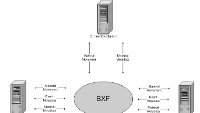SMPTE completes first phase of standardization process for Broadcast eXchange Format

For the past year a Working Group within The Society of Motion Picture and Television Engineers (SMPTE) has been developing new documentation to establish a common practice for exchanging schedule, as-run, content metadata, and content transfer instructions between broadcast automation and traffic systems or asset management systems.
This proposed standard, a revised version of an earlier model called the Broadcast eXchange Format (BXF) standard 2.0, has already been adopted by broadcast equipment vendors such as Grass Valley, Harris and Sony, and is now in use by large media organizations with multichannel automation operations. In total, some 100 representatives from companies and broadcasters themselves have been included in the SMPTE process and are now or will soon be offering the capability in their respective products.
BXF provides a standardized means of exchanging schedule, as-run, content metadata and content transfer instructions between systems. Publication of the new documents is a critical first step in the development of BXF 2.0, which is a collection of projects Harris has promoted within SMPTE to enhance the original BXF standard.
Peter Symes, director of standards and engineering at SMPTE, called BXF “a real success story for SMPTE and all involved.”
The leader of the Working Group is Chris Lennon, an employee of Harris Broadcast Communications, who came up with the idea of a standard file exchange format more than four years ago. Harris has implemented BXF in 11 different products alone since then. As part of a first phase, five documents are now standardized and ready for real-world implementation. In fact, many have been implemented already.
“There are additional things we have targeted on the road map that still need to be completed by the end of this year that will result in new and updated versions of these just released documents,” Lennon said, adding that first one they are set to tackle is developing seamless compatibility between BXF and the MXF for audio and video content file exchange, called the “BXF/MXF Metadata Mapping Standard.” The two interchange standards are related but BXF is designed for data other than that related to audio and video.
“The good thing about this BXF initiative is that it provides standardization communication between all types of systems, regardless of manufacturer,” Lennon said. “We have to continue working because any software-related standard that remains static for a period of even a few years runs the risk of becoming obsolete.”
Get the TV Tech Newsletter
The professional video industry's #1 source for news, trends and product and tech information. Sign up below.
The suite of recently released documents serve as the foundation for further BXF 2.0 development, replacing an original 640-page SMPTE (ST 2021:2008) BXF document.
Enabling near real-time exchange of data, BXF allows adopters to achieve greater operational efficiency and significant cost savings, as well as generate all-new revenues. For example, BXF enables adopters to book last-minute advertising spots in their traffic systems, and have the playout schedule automatically updated in their automation systems — right up to air time.
The five published BXF documents include: SMPTE 2021-0:2009; SMPTE ST2021-1:2009; SMPTE ST 2021-2:2009; SMPTE EG 2021-3:2009; and SMPTE EG 2021-4:2009, which features complete documentation of all of the BXF schemas.
